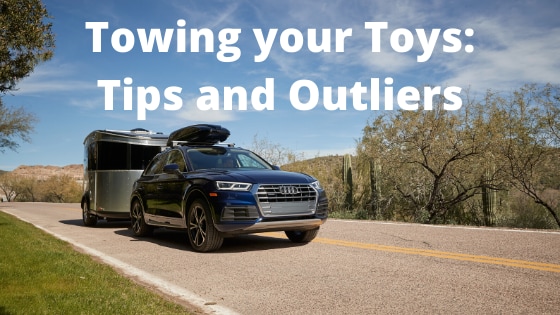
Towing your Toys: Tips and Outliers
Snowbirds heading south for winter often take their cars, trailers, RVs, caravans, boats, or snowmobiles with them. Consider a few safety tips regarding towing and you’ll have a safer and more convenient trip.
Why Is Towing Capacity so Important?
Towing capacity is the maximum weight your vehicle can safely tow. A wide range of vehicles is suitable for towing, not just trucks.
An overloaded trailer puts stress on your vehicle, which results in erratic acceleration, braking, and steering. If you can’t control your vehicle, the trailer will begin to sway or begin running back and forth across the road. This can often result in loss of control, running off the road, or clipping other drivers.
Gross Trailer Weight and Gross Combination Weight Rating
The Gross Trailer Weight (GTR) is the weight of the trailer vehicle and everything it’s carrying.
The Gross Vehicle Weight Rating (GVWR) is the maximum allowed weight of a single-vehicle.
The Gross Combination Weight Rating (GCWR) is the maximum weight you can tow with your vehicle including the GTR. You’ll find the GCWR in your owner’s manual for your vehicle. When considering whether you’ll reach the GCWR for your vehicle, you must also think about any other weight you’re lugging, such as cargo in the cabin, fuel, vehicle occupants, and payload weight in the trunk or cargo bed.
You also need to understand the tongue weight of your trailer. The tongue weight is the weight on the trailer that’s pushing down on the towing vehicle. It’s usually between 9-14% of the GTR. If your tongue weight overloads the supported weight of your towing vehicle, it’ll put a lot of stress on the vehicle and cause excess trailer sway.
When you’re purchasing a car, truck, or SUV, ask about the towing capacity and GCRW. It’ll help you make an informed decision and choose a vehicle that’ll handle towing more than you need. If you’re going to tow larger items like boats or caravans, you may require an HD truck that’s specially designed for larger payloads and more towing capacity.
Trailer Hitches
Traditional trailer hitches (bumper-pull hitches) have multiple classes ranging from lightweight Class I to heavy Class V. These are the typical ball and hitch systems.
- Class I – 2,000 pounds or less – most compact and subcompact SUVs will tow up to 2,000 pounds. The Honda CR-V, for example, is rated to 1,500 pounds, and the Jeep Renegade will pull up to 2,000 pounds. You’ll be able to tow small utility trailers and personal watercraft.
- Class II – 3,500 pounds or less – Equipped with a Class II hitch, your vehicle will be able to tow a couple of ATVs or a small outboard boat. You’ll need a compact or midsize SUV that supports that GCWR, such as the Ford Escape or Chevy Equinox.
- Class III Carrying – 6,000 pounds or less – At this class, you’ll be able to tow some RVs or a small horse trailer. An example of a midsize SUV capable of Class III is the Subaru Ascent.
- Class III Distributing – 10,000 pounds or less – A weight-distributing Class III hitch spreads the trailer weight across all axles of the towing vehicle and trailer. Many compact pickups and midsize SUVs can handle this when properly equipped, such as the Nissan Armada, Dodge Durango, GMC Canyon, and the Ford Expedition.
- Class IV – 10,000 pounds of less – Larger travel trailers and construction equipment can be towed with a Class IV trailer. You’ll need a vehicle up to the task such as a full-size SUV.
There are also other trailer hitches such as gooseneck and fifth-wheel hitches that are for heavier loads. Most trucks don’t have a gooseneck hitch as standard and you’ll have to get it fitted. Gooseneck hitches do allow you to make tighter turns with trailers and RVs and trailer sway is reduced compared to bumper-pull hitches.
Over 12,000 pounds and you’re moving into the realm of heavy-duty pickups. These trucks, like the Ram 2500/3500, Chevrolet Silverado HD, or Ford Super Duty are essentially versions of their light-duty counterparts with more rigid suspension and grunt to pull heavier loads. Ride quality does tend to take a dip.
So, when choosing a new vehicle, be mindful of how much you might need to tow and what the vehicle supports. Also consider whether to install towing upgrades or special technologies in full-size SUVs and trucks that make trailering easier too, such as trailer sway control, rearview cameras, and backup assistance.
Try out your setup before you head out as the additional weight being towed can completely change how your vehicle feels on the road.